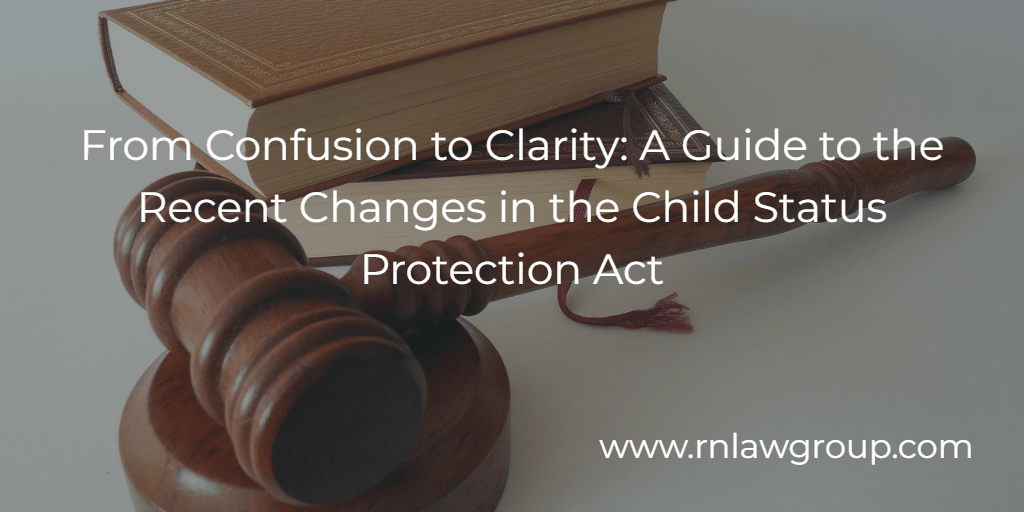
From Confusion to Clarity: A Guide to the Recent Changes in the Child Status Protection Act
What is the Child Status Protection Act (CSPA)?
In order to solve the issue of children aging out of their eligibility for immigration benefits when their parents applied for them, the Child Status Protection Act (CSPA) was passed in 2002. The CSPA was created to safeguard the immigration status of kids who were applying with their parents for a green card, or lawful permanent residence.
Why is the CSPA Necessary?
Before the CSPA, a child was no longer regarded as a “child” under immigration law and thus no longer qualified for a green card with their parents if they turned 21 before their immigration application was approved. Children were frequently separated from their families as a result, and the future of their immigration journey was unclear.
The CSPA was passed to address this problem by offering a way to “freeze” a child’s age for immigration purposes and maintain the child’s eligibility for a green card, even if they turned 21 while their application was being processed. As a result, families are kept together and kids have a better road to citizenship.
Who Can Benefit from the CSPA?
A son or daughter applying for adjustment of status based on a parent’s employment-based green card must satisfy the following criteria in order to be eligible for CSPA:
- The applicant’s calculated CSPA age must be under 21;
- the applicant must remain single; and,
- barring extraordinary circumstances, the applicant must have attempted to obtain lawful permanent residence within one year of the availability of a visa.
For Employment-Based green card applicants, children under 21 can apply for adjustment of status along with their parents. In addition, those who have a CSPA age of under 21 can also adjust with their parents.
How is the CSPA Age Calculated?
The CSPA age is determined by subtracting the number of days the parent’s I-140 petition was pending from the applicant’s age on the date the immigrant visa becomes available to the applicant.
Two prerequisites must be satisfied for the immigrant visa to be regarded as available for CSPA purposes:
- The I-140 petition needs to be approved, and
- The visa must be available for the priority date and immigrant preference category.
The later of these two dates is therefore the day the visa is deemed available:
- the day the petition was approved; or
- the first day on the month when the visa becomes available.
Effective February 14, 2023, the date that an immigrant visa becomes available for those eligible to file under the Dates for Filing chart is now based on the Dates for Filing chart in the monthly Visa Bulletin instead of the Final Action Date chart. See the USCIS announcement.
When USCIS announces that prospective applicants may use the Dates for Filing chart when submitting adjustment of status applications USCIS will also use the Dates for Filing chart to determine the applicant’s CSPA age.
However, when USCIS specifies that a prospective applicant must use the Final Action Dates chart when submitting an application for adjustment of status, USCIS will determine the applicant’s CSPA age using only the Final Action Dates chart.
This will be an important distinction to take note of when an I-1485 application is filed concurrently with an I-140 petition. In that situation, the applicant must wait until the I-140 is approved to determine his or her CSPA age. USCIS will look to the Visa Bulletin for the month the I-140 was approved and which chart’s cut-off date is to be used will depend on which chart USCIS indicates must be used in that month. In other words, it may not always be the Dates for Filing chart that is used to calculate CSPA age.
Why is this Important?
Due to this modification, certain kids with pending applications may now have CSPA ages that are lower than 21. For instance, per the Dates for Filing table in the Visa Bulletin, certain noncitizens were allowed to submit their petitions for adjustment of status between October and December of 2020. The Final Action Date chart, however, was never far enough along for their applications to be approved because a visa was not considered available. Without knowing whether the CSPA would help them, these kids submitted their applications for adjustment of status together with their parents, including paying the filing fee.
Now that USCIS will compute these kids’ ages for CSPA purposes using the Dates for Filing chart, they will have additional assurance that they are qualified to adjust status with their parents. These kids will be able to apply for employment and travel authorization based on their pending adjustment of status. This can also eliminate the need for many kids to change status to F-1 as a backup plan because they could not reliably determine whether they could adjust with their parents previously.
It is important to note that those who filed the I-485 concurrently with an I-140 in the October through December 2020 timeframe may not ultimately benefit from this change. The Visa Bulletin for the month that the I-140 petition was approved must be consulted and it must be determined whether USCIS allowed the use of the Dates for Filing chart or the Final Action Date chart. Once the proper chart is determined, then analysis must be done regarding whether a visa was available at that time. If the priority date was no longer current under the proper chart, then the child’s age would not be frozen yet.
What if my I-485 was already denied due to the old CSPA policy requiring the use of the Final Action Date chart?
USCIS has given the opportunity for previously denied adjustment of status applicants to file a Motion to Reopen if this new interpretation would have made the child eligible. Contact our office to determine whether you may be eligible for a Motion to Reopen. Reddy Neumann Brown PC is available to assist with these cases.
What if there are Multiple I-140 Petitions?
The parent’s I-140 petition that serves as the foundation for the application for adjustment of status is used to determine the applicant’s CSPA age if the parent has multiple approved petitions. This also holds true in situations where USCIS grants a request to change the immigrant category on which the basis of a pending adjustment of status application is based (transfer of underlying basis). The approved petition, which serves as the new foundation for the adjustment of status application, is used to determine the applicant’s CSPA age.
By: Emily Neumann
Emily Neumann is Managing Partner at Reddy Neumann Brown PC. with over 15 years of experience practicing US immigration law providing services to U.S. businesses and multinational corporations. Emily has helped transform the firm from a solo practice to Houston’s largest immigration law firm focused exclusively on U.S. employment-based immigration. She received her Bachelor’s degree in Biology from Central Michigan University and her Juris Doctorate degree from the University of Houston Law Center. Emily has been quoted in Bloomberg Law, U.S. News & World Report, Inside Higher Ed, and The Times of India on various hot topics in immigration. She is a member of the American Immigration Lawyers Association and Society for Human Resource Management.
In today’s global economy, being able to navigate the immigration process is critical to your business success. If you are a Legal Dreamer ageing out, speak with one of our immigration lawyers. Please contact us online, call our Houston business immigration attorney office directly at 713-953-7787, or schedule a consultation.

